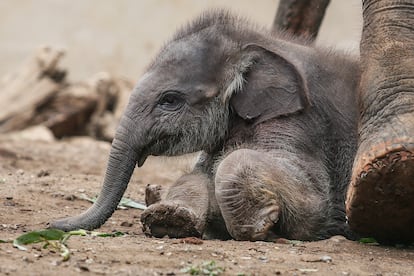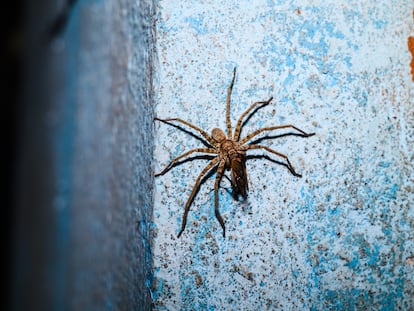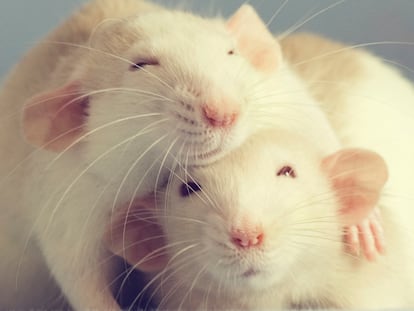Elephant calves have been found buried – what does that mean?
The unusual positioning and injuries suggestive of dragging after death point to intentional burial practices

The myth of elephant graveyards has pervaded popular culture, and recent observations of buried Asian elephant calves may finally give that legend some credence.
In the research published in the Journal of Threatened Taxa, two scientists describe five instances where elephant calves have been found buried in a legs-upright position within irrigation trenches of tea plantations in northern Bengal, India. The authors argue that the unusual positioning, the surrounding ground being compacted by the feet of several elephants and injuries suggestive of dragging after death, all point to intentional burial practices.
If this conclusion is accurate, these observations could indicate an understanding of death and grief potentially unlike anything else we’ve seen in the animal kingdom, revealing yet another way in which humans are not as unique as previously thought.
Archaeological evidence suggests our hominid ancestors have been burying their dead for at least 100,000 years — potentially much longer. Burials are intriguing because of what they suggest about the minds of those doing the burying. For us — and presumably for our ancestors who started this practice — burial is not just about disposing of bodies, but an expression of grief and an honoring of the life that has passed.
Across cultures, people put time and effort into the rituals of burial as a way of commemorating life. Burials are a clear indication of our sentience and empathy. Indeed, it is commonly believed that our reactions to death signify humanity. To date, evidence of similar mental representations of death are scarce in other animal species, and despite a few anecdotes, no animal species has been found to systematically bury their dead in the ritualized way that we do.
Are elephant burials intentional?
It may be too early to cross burials off the uniquely human list. While the recent reports of calf burials are intriguing, these five burials were not directly observed, so questions remain. It is possible, for example, that dead or weak calves fell into the trenches as they were being carried, before the ensuing panic of the family caused the trench to collapse around the body.
Ever heard about a phenomenon called as #Elephant burials ! Few have heard but rarely document it from India. Here we publish first of its kid study from #India of Asian elephant burials with multiple real documentation in ‘Journal of Threatened Taxa’https://t.co/cJCu5wLCLa… pic.twitter.com/wsr10o1OpM
— Parveen Kaswan, IFS (@ParveenKaswan) February 28, 2024
However, reports of burial are at least consistent with what we know about elephants’ acute reactions to death. Elephants have been observed carrying corpses of dead infants. They frequently show a change in behavior as they approach a carcass of a family member or another individual.
This response can involve silent investigating, sniffing and touching body parts with their head held low, perhaps trying to move or rouse the carcass, and on rare occasions, placing mud or large palm fronds over the bodies of dead relatives. This all likely amounts to what, in humans, we would recognize as grief or mourning.
Understanding death
Of course, elephants are not the only animals to show interesting reactions to dead associates. Crows often gather around and mob the carcass of another dead crow, in what has sometimes been called a funeral. This social gathering appears to provide the crows with an opportunity to learn about a danger to be avoided, lest they end up in the same state (as opposed to offering the chance to say goodbye in the traditional sense of funerals).
Even some social insects, such as ants, will clear away their dead. When ants detect certain chemicals released by dying or dead individuals in their colony, it induces them to remove the bodies — and in a few species even to bury them — in order to limit the possibility of disease transfer.
However, as researchers that study animal behavior and, more specifically, grief, we have no reason to assume this extraordinary “corpse management” behavior means that the ants have any understanding of life or death.
In the 1950s, biologist and entomologist E.O. Wilson applied the critical chemical to live ants, causing nest mates to respond as they would to a dead animal. They tried to drag the unfortunate individual out of the nest and dumped them a safe distance away.
Similar responses to the chemicals of decay have been noted in rats, who bury others that have been dead for long enough to turn putrid. Like Wilson’s ants, they also try to bury anesthetized — but still living — rats sprinkled with the signature scent of decomposition. They even try to bury wooden sticks that have the same scent. Some social living animals are hard-wired to remove decaying items from their nest area.
These examples in rats and ants are clearly different to human burial, and to the mourning behavior we see in elephants and several other species, including orcas.
While the jury may still be out on whether or not elephants really choose to bury their dead, their emotional reactions to the death of family members or associates are undeniably extraordinary and deeply moving to observe. These reactions remain difficult to explain adequately without suggesting that elephants do have some kind of concept of death.
Lucy A. Bates is a senior lecturer in Comparative and Evolutionary Psychology at the University of Portsmouth.
Leanne Proops is an associate professor of Animal Behavior and Welfare at the University of Portsmouth.
This article was originally published in The Conversation.
Sign up for our weekly newsletter to get more English-language news coverage from EL PAÍS USA Edition
Tu suscripción se está usando en otro dispositivo
¿Quieres añadir otro usuario a tu suscripción?
Si continúas leyendo en este dispositivo, no se podrá leer en el otro.
FlechaTu suscripción se está usando en otro dispositivo y solo puedes acceder a EL PAÍS desde un dispositivo a la vez.
Si quieres compartir tu cuenta, cambia tu suscripción a la modalidad Premium, así podrás añadir otro usuario. Cada uno accederá con su propia cuenta de email, lo que os permitirá personalizar vuestra experiencia en EL PAÍS.
¿Tienes una suscripción de empresa? Accede aquí para contratar más cuentas.
En el caso de no saber quién está usando tu cuenta, te recomendamos cambiar tu contraseña aquí.
Si decides continuar compartiendo tu cuenta, este mensaje se mostrará en tu dispositivo y en el de la otra persona que está usando tu cuenta de forma indefinida, afectando a tu experiencia de lectura. Puedes consultar aquí los términos y condiciones de la suscripción digital.
More information
Archived In
Últimas noticias
Most viewed
- The Florida Keys tourist paradise is besieged by immigration agents: ‘We’ve never seen anything like this’
- Charles Dubouloz, mountaineering star, retires at 36 with a farewell tour inspired by Walter Bonatti
- CBS in crisis after pulling a report on Trump’s deportations to El Salvador (which later leaked online)
- Chevy Chase, the beloved comedian who was a monster off camera: ‘Not everyone hated him, just the people who’ve worked with him’
- December Social Security and SSI payments: Dates, double checks and the 2026 COLA increase










































